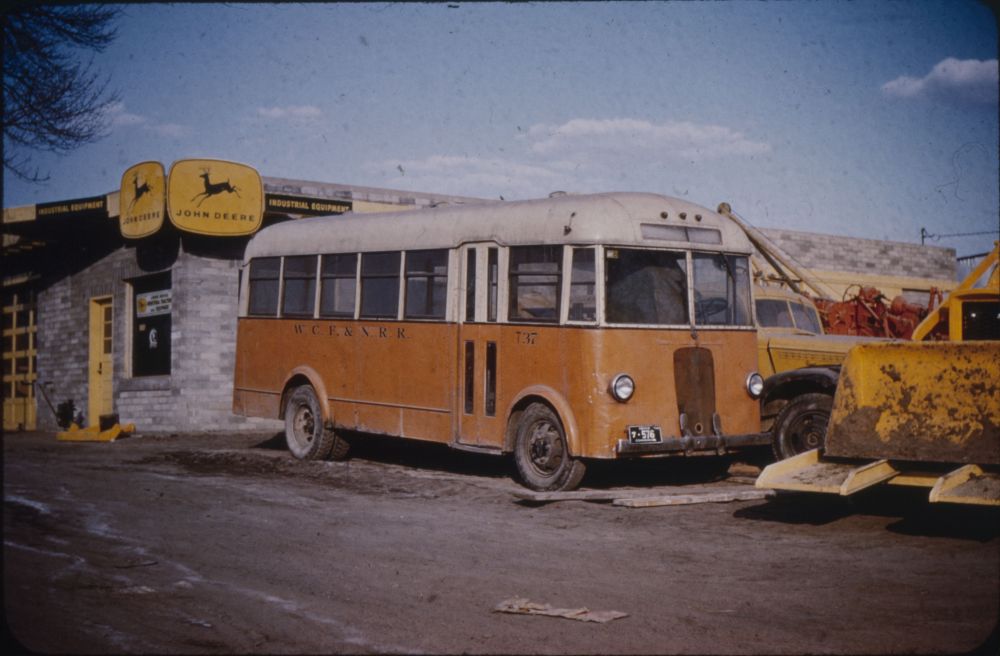
Dave Rogers photo on 10/27/23
- Builder
- Yellow Truck & Coach Mfg. Co.
- Description
- Model 733
- Type
- Motor Buses
- Year
- 1937
- Acquired by the Museum
- 1998
- Note
- No. 35 is not in operating condition but, otherwise, is in relatively good condition.
- Fund
- 733
Waterloo, Cedar Falls & Northern Railroad 35
From Waterloo, Iowa
History
Yellow Coach Manufacturing Company was formed in 1923, initially a subsidiary of Yellow Cab Company. General Motors acquired a controlling interest in 1925 and renamed the company Yellow Truck and Coach, although it was commonly still termed “Yellow Coach.” Yellow Coach merged into General Motors in 1943. During 1923-1943, Yellow Coach was a major bus producer both for long distance carriers as well as transit systems that were converting fleets from streetcars to buses. In 1931, Yellow began producing its 700 series buses with flat fronts and rear engines which was an innovation at the time. Later, some 700 series buses, including model 733, had engines in the front to meet the preference of some customers. Model 733 was a small transit bus with 21 seats and was used primarily in smaller cities.
Yellow Coach built model 773, serial number 733 984 for the Waterloo, Cedar Falls & Northern Railroad (WCF&N) in 1937 as their No. 35. The WCF&N was an electric interurban railroad with a 64-mile main line between Waterloo and Cedar Rapids, IA and with branches from Waterloo to Waverly and Cedar Falls, IA. The company also provided local streetcar service in Waterloo and Cedar Falls. The railroad began supplementing rail service with buses in the 1920s. WCF&N operated buses between Waterloo and Cedar Rapids as well as in local service in Waterloo and Cedar Falls. The WCF&N converted local service in Waterloo and Cedar Falls from streetcars to buses in 1936. In 1936-37, the company purchased 23 buses, mostly from the Yellow Coach subsidiary of General Motors, for this expansion of bus service. This included the purchase of Yellow Coach model 733 buses, Nos. 35-37, in 1937 for $11,010 for the group of three. These relatively small buses operated in Waterloo and Cedar Falls local service rather than on the longer route to Cedar Rapids.
In the 1930s, the WCF&N’s bus paint scheme was silver (aluminum) with a red stripe edged in black. This was a standard scheme that Yellow Coach used on buses for many of its customers. After World War II, the WCF&N painted its buses traction orange and cream to match the colors on its interurban rail cars.
The WCF&N replaced No. 35 and other pre-war buses with newer buses in 1947-49. In 1953, St. John’s Transportation Company bought the Waterloo area transit system from the WCF&N. The WCF&N continued bus and interurban service between Waterloo and Cedar Rapids until 1958. Then, a remnant continued with diesel freight service as the Waterloo Railroad.
In 1949, the WCF&N sold buses No. 35 and 36 for $700, each, to Watertown Transit Company, Arnold C. Travland, Owner. Travland was a banker in Aberdeen, SD, but no information about Watertown Transit has been found. Perhaps, Travland did not initially operate the pair of buses. Then, in 1951, Travland and a partner, Oscar Herbold, received the franchise to operate bus service in Aberdeen, SD. This replaced Aberdeen service operated by Hyde Hub City Bus which had suspended operations in May 1951. Travland’s operation was named Hub City Transit Company and is believed to have used the former WCF&N bus No. 35. Hub City ended service in 1955 - the last local bus service in Aberdeen. No. 35 became a back yard play area/shed.
About 1980, Seashore member Ira Schreiber acquired the bus from a junkyard in Aberdeen, SD. Schreiber gave the bus to Lincoln Transportation System (renamed StarTran in 1988) in Lincoln, Nebraska. Lincoln Transportation was the city-owned successor to Lincoln Traction Company and Lincoln City Lines. Lincoln Traction began replacing streetcars with buses in 1926, and the last streetcar ran in 1945. Lincoln Traction had owned two Yellow model 733 buses acquired second-hand from Aurora-Elgin City Lines, in Illinois, in 1943. Schreiber worked with Lincoln Transportation to restore No. 35. Seats were installed, and the bus was made operational. It was painted bright yellow with a red belt rail and gold lettering. It was numbered “733”. The bus was used for parades and special events to represent Lincoln’s original model 733s. During this period, No. 733 was operated along with a Birney streetcar body mounted on a trailer. The streetcar body was owned by a priest, Father Les Canes.
In 1998, StarTran donated their No. 733 to Seashore. The museum refurbished the bus and operated it around the museum site. Seashore has generally stored the bus inside the Fairview carbarn. In 2021, Seashore displayed the bus at the museum entrance for the holiday “Prelude” events. At Seashore, WCF&N bus No. 35 joins Lancaster No. 3 which is another model 733 from Yellow Coach. No. 35 is believed to be the only surviving WCF&N bus. It may be the only surviving Aberdeen, SD bus. There are no surviving WCF&N interurban cars. Only one WCF&N streetcar survives (at the Midwest Electric Railway in Mount Pleasant, IA). In 2023, Seashore restored the exterior of No. 35 to its late 1940s appearance at the WCF&N.
Technical Information
- Seats: 21
- Engine: Chevy 6 cylinder inline gas
- Tires: 7.50 x 18
Weight and Dimensions
- Length: 23’ 6.00"
- Width: 6’ 10.00"
- Height: 9’ 6.00"
- Weight: 6720 lbs.
Additional Images

Dave Rogers photo on 10/27/23

At the John Deere tractor factory in Waterloo during WWII – Robert Levis Collection

Sister coach #37 converted into a truck Late '50's or early '60's - Robert Levis Collection
© 1998 - 2025 New England Electric Railway Historical Society. All Rights Reserved.